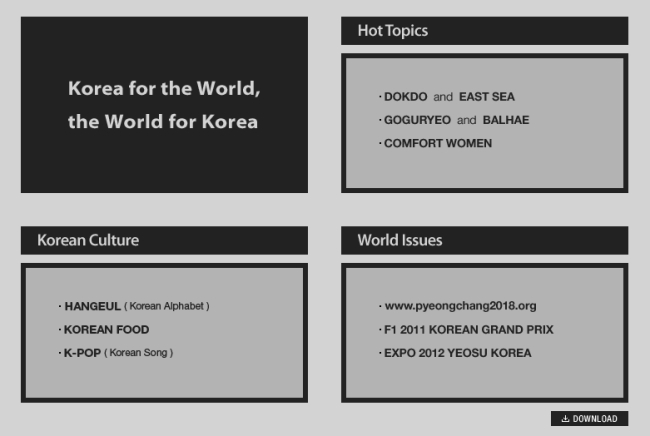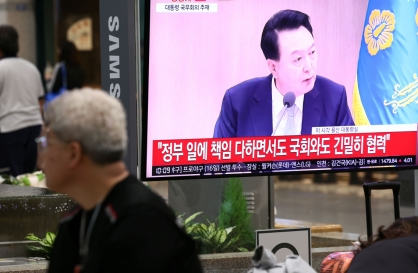
미국의 대표적인 공영방송인 NPR(국립공영라디오)이 텍사스 레인저스의 추신수 선수를 모델로 내세운 불고기 광고가 독자들에게 혼란을 준다고 비평했다.
NPR의 시니어 에디터 루이스 클레멘스(Luis Clemens)는 지난 13일 뉴욕타임즈에 실린 ‘BULGOGI?(불고기?)’라는 문구로 시작하는 광고는 여러 측면에서 이해하기 어려웠다고 14일 온라인 기사를 통해 전했다.
그는 특정한 식품회사가 아닌 한국 음식인 불고기 자체를 홍보하는 이유를 모르겠다며 “비슷한 예를 상상하기도 어렵지만” 예를 들자면 미국 팝스타 “저스틴 팀버레이크가 영국 신문에 햄버거의 기막힌 맛을 선전하는 것과 같을 것”이라며 “버거킹이나 맥도날드, 웬디스도 아닌 그냥 햄버거 말이다”라며 광고의 의도가 불명확하다고 지적했다.
이 광고는 이미 국내에서는 잘 알려진 한국홍보전문가 서경덕 성신여대 교수가 지난 2005년부터 가수 김장훈과 함께 진행한 독도 광고를 시작으로 배우 송일국, 이영애 등과 함께 우리나라의 먹거리를 전세계에 알리는 캠페인 중 하나다.
국내에서는 이러한 우리 문화 홍보의 움직임과 서경덕 교수의 개인적인 노력이 알려져 있는 반면, 정작 이 광고를 접하는 외국인들이 보기에는 이해하기 어려운 점들이 많아 기대하는 홍보 효과를 거둘 수 있을지 우려가 예상된다.
NPR은 광고카피에 쓰인 부자연스러운 영어 표현에 대한 문제점도 지적했다.
추신수 선수가 불고기를 권하는 사진 좌측에 위치한 짧은 네 문장의 광고 카피 중 “봄이 왔고 난 경기할 준비가 됐다!” (Spring’s here and I’m ready to play!”)라는 표현은 원어민이 쓰지 않는 표현일뿐더러 느낌표 사용도 부적절하다는 지적이다.

클레멘스는 불고기 광고에 대한 이해와 출처를 알아내기 위해 광고 하단에 쓰여있던 웹사이트 (ForTheNextGeneration.com)를 방문했지만 혼란이 가중되기만 했다고 밝혔다.
문제는 사이트 구성에 있었다. 우리에겐 익숙한 위안부, 독도 문제지만 한국에 대한 이해가 떨어지는 외국인에게는 서로 동떨어진 주제인 케이팝(K-pop), 2018 평창 동계올림픽, 한글 홍보 등이 망라되어있는 사이트 구성이 설득력을 잃었다.
그는 사이트를 둘러본 후 “불고기 광고가 한국 음식과 음료를 알리기 위한 홍보 시리즈의 하나라는 것을 깨달았지만 아직도 이 웹사이트가 왜 ‘위안부’와 ‘한-일간 영토 분쟁’에 대한 섹션을 포함하고 있는지 이해할 수 없다”고 전했다.
그는 또 사이트에 쓰여있는 연락처를 통해 접근을 시도했지만 연결되지 않았다고 덧붙였다.
인터넷 검색으로 서경덕 교수의 트위터 계정을 발견한 클레멘스는 서 교수가 포스팅한 기사들을 통해 그가 뉴욕 타임스퀘어에 비빔밥 광고를 게재했으며 이번 불고기 광고비용의 후원사가 치킨마루라는 사실을 알게 됐다고 전했다.
그는 이 모든 사실을 추적으로 찾아낸 단서들을 통해 알아가야 만 했던 것에 아쉬움을 토로하면서 “보도에 따르면 올해 서 교수가 이집트와 카자흐스탄으로 한국 음식 홍보를 확대할 계획을 가지고 있는 것 같다. 아마 이번 불고기 광고는 아랍이나 카자흐스탄에서 더 잘 통할 것 같다”고 말했다.
코리아헤럴드 박한나 기자 (hnparkkhnews@heraldcorp.com">@heraldcorp.com)
<관련 영문 기사>
U.S. media says bulgogi ad on NYT ‘disorienting’
From Korea’s easternmost islets of Dokdo to the country’s popular dish bulgogi, a series of national items have been the subjects of high-profile ads that Sungshin Women’s University professor Seo Kyung-duk ran in various U.S. media outlets.
But his costly promotional campaign seems to have failed to drive home his heartfelt messages to some of the American audience due to hard-to-grasp content and confusing storytelling methods.
U.S. National Public Radio on Friday criticized Seo’s ad for bulgogi, grilled marinated beef, printed in The New York Times, saying it confused the audience with what the reporter deemed poorly written promotional copy.
“What was with the promotion of a national dish rather than a brand? … it would be like Justin Timberlake appearing in a British newspaper ad touting the great taste of hamburgers,” NPR senior editor Luis Clemens wrote in an article posted online last Friday.
The bulgogi ad with baseball player Choo Shin-soo as a model is part of a promotional series to advertise Korean culture and food by Seo, who is known as a “Korea PR Expert” among Koreans since he first placed a full-page ad in The New York Times in 2005 on Dokdo.
But like many who saw the advertisement without background information on the campaign, Clemens said he had difficulty understanding the concept and finding a connection between Choo and bulgogi.
“I was baffled…Was the ad seriously promoting grilled, marinated beef as an essential part of a spring training regimen? Is that why a Texas Rangers outfielder Choo Shin-soo was inviting us all to try bulgogi?” Clemens said.
He also wrote that it was “weird” to see copy that seemed to be written by a non-native speaker of English.
“‘Spring’s here and I’m ready to play!’ Who says that? Why the exclamation point?” he wrote.
A website listed at the bottom of the ad, FortheNextGeneration.com, which is supposed to provide more information about the campaign, led to greater confusion, according to the NPR report.
The main page of the archive-style website features three categories -- hot topic, Korean culture and world issues -- which broke down into three sections for each.
For example, the hot topic section was divided into Dokdo and the East Sea, Goguryeo and Balhae, and comfort women, with each page showing links to related articles and previously published advertisements.
Clemens pointed out the incoherent categorization of the website by saying, “I still didn’t understand why the website contains sections on comfort women and the territorial dispute between Japan and Korea.”
He added that he contacted the email and phone numbers listed on the site for more information but failed to reach anyone.
By Park Han-na (hnpark@heraldcorp.com)
U.S. media says bulgogi ad on NYT ‘disorienting’
From Korea’s easternmost islets of Dokdo to the country’s popular dish bulgogi, a series of national items have been the subjects of high-profile ads that Sungshin Women’s University professor Seo Kyung-duk ran in various U.S. media outlets.
But his costly promotional campaign seems to have failed to drive home his heartfelt messages to some of the American audience due to hard-to-grasp content and confusing storytelling methods.
U.S. National Public Radio on Friday criticized Seo’s ad for bulgogi, grilled marinated beef, printed in The New York Times, saying it confused the audience with what the reporter deemed poorly written promotional copy.
“What was with the promotion of a national dish rather than a brand? … it would be like Justin Timberlake appearing in a British newspaper ad touting the great taste of hamburgers,” NPR senior editor Luis Clemens wrote in an article posted online last Friday.
The bulgogi ad with baseball player Choo Shin-soo as a model is part of a promotional series to advertise Korean culture and food by Seo, who is known as a “Korea PR Expert” among Koreans since he first placed a full-page ad in The New York Times in 2005 on Dokdo.
But like many who saw the advertisement without background information on the campaign, Clemens said he had difficulty understanding the concept and finding a connection between Choo and bulgogi.
“I was baffled…Was the ad seriously promoting grilled, marinated beef as an essential part of a spring training regimen? Is that why a Texas Rangers outfielder Choo Shin-soo was inviting us all to try bulgogi?” Clemens said.
He also wrote that it was “weird” to see copy that seemed to be written by a non-native speaker of English.
“‘Spring’s here and I’m ready to play!’ Who says that? Why the exclamation point?” he wrote.
A website listed at the bottom of the ad, FortheNextGeneration.com, which is supposed to provide more information about the campaign, led to greater confusion, according to the NPR report.
The main page of the archive-style website features three categories -- hot topic, Korean culture and world issues -- which broke down into three sections for each.
For example, the hot topic section was divided into Dokdo and the East Sea, Goguryeo and Balhae, and comfort women, with each page showing links to related articles and previously published advertisements.
Clemens pointed out the incoherent categorization of the website by saying, “I still didn’t understand why the website contains sections on comfort women and the territorial dispute between Japan and Korea.”
He added that he contacted the email and phone numbers listed on the site for more information but failed to reach anyone.
By Park Han-na (hnpark@heraldcorp.com)







![[From the Scene] Monks, Buddhists hail return of remains of Buddhas](http://res.heraldm.com/phpwas/restmb_idxmake.php?idx=644&simg=/content/image/2024/04/19/20240419050617_0.jpg&u=20240419175937)






![[From the Scene] Monks, Buddhists hail return of remains of Buddhas](http://res.heraldm.com/phpwas/restmb_idxmake.php?idx=652&simg=/content/image/2024/04/19/20240419050617_0.jpg&u=20240419175937)

![[KH Explains] Hyundai's full hybrid edge to pay off amid slow transition to pure EVs](http://res.heraldm.com/phpwas/restmb_idxmake.php?idx=652&simg=/content/image/2024/04/18/20240418050645_0.jpg&u=20240419100350)

![[Today’s K-pop] Illit drops debut single remix](http://res.heraldm.com/phpwas/restmb_idxmake.php?idx=642&simg=/content/image/2024/04/19/20240419050612_0.jpg&u=)